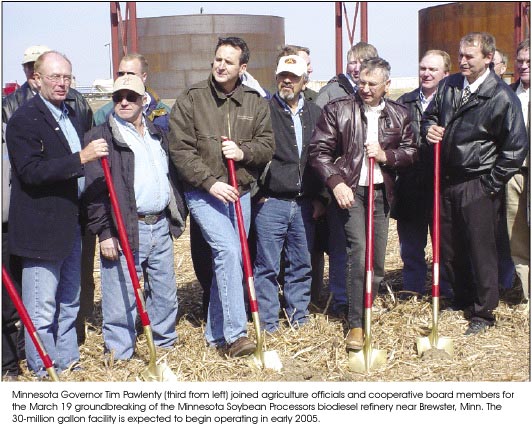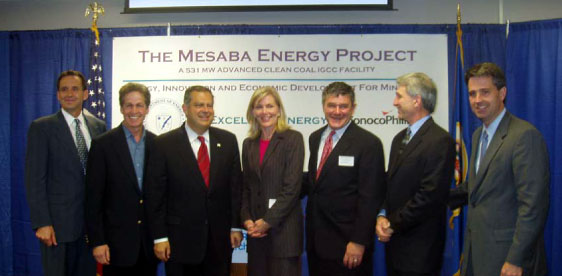Pawlenty Energy Plan – send in the shovels
December 14th, 2006

Pawlenty shoveling it at MN Soybean Growers biodiesel plant – stolen from Ag Innovation News
First, a little background. The Midwest Ag Energy Network Summit was the handiwork of the Joyce Foundation funded Great Plains Institute. The Great Plains Institute, as you may recall, have their “Coal Work Group” to promote coal gasification, and their junkets for coal gasification in 2003 and 2005.
And so you’ve got Gov. Pawlenty introducing his “Next Generation Energy Initiative” at the same time that the Great Plains Institute is delivering its propaganda about … well, take a guess:
A great meal with a huge side of IGCC propaganda. Surprise, surprise, in the Coal part of the meeting, they deliver a rah-rah coal gasification, and at the Brookings meeting, thankfully there was a Russian present who had worked on coal gasification and knew they didn’t have a clue what they were talking about and knew they had no business presenting it as a panacea. Funny how that works. But the problem is that at these Great Plains Institute “Town Hall Meetings” where they SAY they want input from the public, well, they really don’t, and they’re pushing that coal gasification agenda without regard for the actual costs and environmental detriment of IGCC, oh, but wait… remember that Joyce Foundation funding? What did they get that $$$ for? Oh, yeah:
Great Plains Institute for Sustainable Development
Minneapolis, MN $437,500
To support the efforts of its Coal Gasification Working Group. (21 mos.)
PROMOTION OF COAL GASIFICATION. $427,500 buys a few junkets to Europe, a few Town Meetings (Spirit Lake, Iowa tonight) and an Ag Energy Summit or two… and here they are promotiing it, and haven’t incorporated the information from Mesaba that shows that not only is it $6.38/kWh WITHOUT capture and sequestration, but that the overnight cost is $3,259/kW, ummmm… hello, earth to mars, this doesn’t sound like a good idea. So be sure to check out the “Center for Climate Strategies” promotion of coal gasification — search the doings in the states listed, and you’ll see IGCC — not in MY state!!!
… and so anyway, now there’s Pawlenty and his “Next Generation Energy Initiative” and it makes me wonder if there are naming rights for the Gov’s policy packages, sort of like the way there are with legislation, i.e., C-BED the legislation and C-BED the Crocker entity that puts up a different front on the C-BED website.
Pawlenty and Coal Gasification — rumor has it he has said that under the terms of his Next Generation Energy Initiative, Excelsior’s Mesaba project may have to be “grandfathered in.” Oh, so then if that’s the case, doesn’t that mean that the Mesaba Project defacto does not produce the benefits that they’re touting? If it has to be “grandfathered in,” what’s the point? Hmmmmm…. somebody better check that out at the public hearings next week, eh?
Excelsior’s Mesaba Project is contrary to the basic points of Pawlenty’s plan, which focuses on more renewables, increase conservation, and aggressive cuts to CO2 emissions. The Mesaba Project isn’t renewable, it’s construction generation and making Xcel buy electricity it doesn’t need and that we don’t need, and each year it spews over 6,300,000 tons of CO2 into the air.
Somebody better let Pawlenty know that the Excelsior Project isn’t a happenin’ thang… and clue him in on the political consequences of association with this boondoggle… if you have any doubts, just check the Mesaba Project Siting Docket. zzzzzzzzzzzz, shhhhh, don’t wake it up!

———————————————-
GOVERNOR PAWLENTY INTRODUCES NEXT GENERATION ENERGY INITIATIVE
— December 12, 2006
Governor Pawlenty today announced his Next Generation Energy Initiative that will result in more renewable energy, more energy conservation, and less carbon emissions for Minnesota.
In an address to the Midwest Ag Energy Network Summit today in St. Paul, the Governor outlined his proposals that will build on Minnesotaâ??s nation-leading per capita renewable fuel use, while increasing energy cost saving measures and developing a sound approach to emissions.
More Renewables
In his remarks today, the Governor announced his proposal to move the state closer to his 25xâ??25 strategic goal – 25% of all types of our energy will come from renewable sources by 2025.
* Expand and improve the stateâ??s Renewable Energy Objective (REO)
Under the current REO, Minnesota electric utilities to are expected to generate at least 10% of the electricity they supply consumers to come from renewable resources by 2015. Governor Pawlenty is proposing that the REO increase to 25% of the electricity Minnesotans use should come from renewable resources by 2025. In addition, a financial penalty for non-compliance would be imposed if the goal is not reached.
â??The obligation should be firm enough to ensure we reach our goals, but flexible enough to allow utilities and regulators to respond to changing markets, consumer demand and regulatory conditions,â? Governor Pawlenty said.
* E85 Everywhere
To continue Minnesotaâ??s leadership in E85, Governor Pawlenty is proposing the E85 Everywhere program which would quintuple the number of E85 pumps in the state by 2010, an increase from 300 now to 1800 in four years. In addition, the Governorâ??s proposal will help retail station owners with grants to partially offset the cost of E85 pump installations.
* Promote the development of cellulosic ethanol and advanced biomass technologies in Minnesota
Financial resources should be available to assist and encourage the growth of Next Generation biofuels, such as cellulosic ethanol, and advanced bio-gas (gasification of biomass) technologies to offset natural gas use in the state, with a special focus on farmer ownership.
â??I believe this will be Minnesotaâ??s next bio-energy home run,â? Governor Pawlenty said.
More Energy Conservation
â??We have among the nationâ??s best conservation and energy efficiency programs in the country. We can build on this success and save significantly more energy in the coming years,â? Governor Pawlenty said. â??Energy conservation saves Minnesotans real money on their energy costs, while reducing the environmental impacts of our energy use.â?
* Reduce Minnesotaâ??s fossil fuel energy use
Governor Pawlenty set an aggressive energy saving goal for Minnesotans to reduce use of fossil-fuel energy by 15% by 2015. The Governor said that the goal is achievable through increases in energy efficiency and renewable resources.
* Transition the Conservation Improvement Program (CIP) from a spending requirement program to â??energy savedâ? program
The amount of electricity and natural gas we save each year can be significantly increased through additional energy efficiency and conservation measures. Governor Pawlenty is proposing to change Minnesotaâ??s utility energy conservation program from a spending program to an energy savings program and by requiring utilities to reduce their retail sales by 1.5% annually.
â??We should also increase the accountability and transparency of utility conservation activities,â? Governor Pawlenty said. â??Together, these reforms will effectively double the amount of electricity we save and increase natural gas savings by 50%.â?
* Set as a goal of 1,000 Energy Star commercial buildings in the state by 2010
Currently, Minnesota has 87 schools, office buildings, and churches that have received the Energy Star award. Governor Pawlenty is proposing that 1,000 building become Energy Star certified throughout the state.
â??More Energy Star rated buildings will save money, improve the environment and make working in them more enjoyable,â? Governor Pawlenty said.
Less Carbon Emissions
â??Our global climate is warming, at least in part due to the energy sources we use,â? Governor Pawlenty said. â??Minnesotans did not create this problem, nor can we solve it by ourselves, we need an effective national and international effort. That said, we should identify and take a number of reasonable and fair steps that will reduce our greenhouse gas emission, just as we did with our nation-leading mercury emissions reduction legislation.â?
* Establish stakeholder process
Governor Pawlenty is inviting the nationally recognized Center for Climate Strategies to Minnesota to conduct a wide-ranging and inclusive stakeholder process and to develop a plan to aggressively reduce greenhouse gas emissions in Minnesota over the coming years.
* Utility offset
â??Minnesotaâ??s electric utilities should prepare for the future by offsetting carbon emissions from new fossil-fuel generation sources,â? Governor Pawlenty said. â??As we look to reduce our greenhouse gas emissions, we should not make the situation worse while we try to make it better.â?
* Climate Exchange
Governor Pawlenty is proposing that the State of Minnesota join the Chicago Climate Exchange (CCX) or some other national registry that will helps reduce greenhouse gas emissions from state operations. The CCX is a greenhouse gas (GHG) emission registry, reduction and trading system. Members make a voluntary but legally binding commitment to reduce GHG emissions.
â??The Next Generation Energy Initiative provides the pathway to that better energy future,â? Governor Pawlenty said. â??Taking these steps will be good for the environment, good for rural economies, good for national security, and good for consumers.â?
—————————————
The test question: Who put together the Chicago Climate Exchange? Who benefits from commodification of CO2 and its trade in this market?
Bonus question: How does trading a) shift emissions and b) reduce emissions?

Leave a Reply